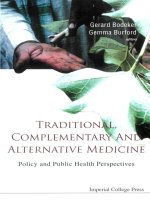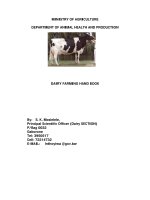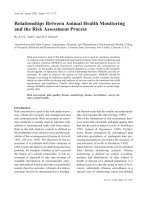Covid-19 and animal health concerns-a veterinarian perspective
Bạn đang xem bản rút gọn của tài liệu. Xem và tải ngay bản đầy đủ của tài liệu tại đây (182.81 KB, 6 trang )
Int.J.Curr.Microbiol.App.Sci (2020) 9(5): xx-xx
International Journal of Current Microbiology and Applied Sciences
ISSN: 2319-7706 Volume 9 Number 5 (2020)
Journal homepage:
Review Article
/>
Covid-19 and Animal Health Concerns-A Veterinarian Perspective
K. Satish Kumar*
Department of Veterinary Medicine, College of Veterinary Science, Rajendranagar
PVNR Telangana Veterinary University, Hyderabad – 30, Telangana State, India
*Corresponding author
ABSTRACT
Keywords
Covid-19,
Animal Health
Concerns
Article Info
Accepted:
15 April 2020
Available Online:
10 May 2020
Though Covid19 is closely related to SARS and MERS, the present SARSCOV-2 is different to these two other corona viruses with respect to mild
infection in 80% of cases and 20% severe. Based on the available literature,
the Covid-19 pandemic is linked to a fish market, though the exact source
is yet to confirm. So far it is understood that this novel corona virus causes
respiratory symptoms and spreads as droplet infection in humans, people
who are infected but asymptomatic also play a role in spread. At the same
time, there is no established evidence that the companion animals can
spread covid19 to humans. It should be understood that any kind of pet and
companion animal is not a vector of the present pandemic, and hence, there
is no reason to abandon the man’s beloved companion.
Introduction
Basically corona viruses are a group of
viruses that causes disease in animals, named
for the crown-like spikes on their surface. The
genus Corona virus is composed of at least
three genetically and antigenically distinct
groups of corona virus that causes mild to
severe enteric, respiratory or systemic disease
in domestic and wild animals, poultry, rodents
and carnivores and mild cold in humans. So
far, there are four main sub-groups (alpha,
beta, gamma and delta) and seven types of
corona viruses (229E, NL63, OC43, HKU1,
MERS-CoV, SARS-CoV and SARS-CoV-2)
have been identified including the recent new
noval corona virus that entered humans, but
most just cause cold (NCIRD, 2020). Though
Covid19 is closely related to SARS and
MERS, which swept around the world in
2002 and 2012, the present SARS-COV-2 is
different to these two other corona viruses
with respect to mild infection in 80% of cases
and 20% severe. Almost every state is
1846
Int.J.Curr.Microbiol.App.Sci (2020) 9(5): xx-xx
affected by COVID-19, but the severity and
stage of the pandemic is at different levels in
different states. Whether it is a human or an
animal, there is total ‘lock down’ in many
places, where the life is confined to the indoor
home environment. Cats and dogs are in close
contact with humans, and therefore it is
important to understand their susceptibility to
SARS-CoV-2 for COVID-19 control.
Covid-19 and animal health
Primarily the SARS and MERS stand as
examples for the corona viral infections that
normally exist in animals but rarely spread to
humans and then human to human. With the
available evidence to date, the present corona
virus pandemic is linked to a wet market, but
the exact source is yet to know. So far it is
understood that this novel corona virus causes
respiratory symptoms in humans and spreads
mostly through droplets from person to
person and people who are infected but
asymptomatic also play a role in spread. At
the same time, there is no established
evidence that the companion animals can
spread covid19 to humans. Basically the
corona virus that causes disease in pet animals
was identified as canine and feline corona
virus. The canine corona virus is usually
restricted to gastro intestinal tract causing
hemorrhagic gastroenteritis and is self
limiting and whereas, the feline corona virus
is associated with feline infectious peritonitis.
However, veterinary scientists reported the
potential for corona viruses to cause fatal
enteric or respiratory infections in animal and
for new corona virus strains to emerge from
unknown reservoirs occasionally leading to
fatal disease in naive population. Pensaert
(1999) reported the outbreak of porcine
epidemic diarrhoea corona virus (PEDV)
during early 80s that caused severe enteritis
and mortality in baby pigs. The PEDV is
more closely related genotypically to human
CoV 229E than animal CoV (Duarte et al.,
1994) that grows in vero cells like SARS Cov
(Hoffman and Wayler 1988).
The emergence of SARS illustrate that these
corona viruses are highly virulent particularly
when they emerge from its natural animal
reservoir and causes highly fatal in humans
(Saif, 2004). Historically, human corona virus
infections were mostly associated with simple
common cold (Callow et al., 1990 and
Holmes 2001) with exceptions like emergence
of new corona virus that was associated with
SARS in 2003 (Drosten et al., 2003, Poutanen
et al., 2003). The SARS CoV is genetically
related to known CoVs and comprises a
provisional new group –IV (Drosten et al.,
2003) or alternatively, using rooted tree
phylogenetic analysis, belongs to a subgroup
of group II (Snijder et al., 2003).
While there are isolated reports of infected or
asymptomatic human patients transmitting the
SARS-CoV-2 to their pets, there are no
published reports of these pets spreading virus
to other animals or people. According to
American Kennel Club proceedings, dogs can
contract certain types of corona viruses, such
as canine respiratory corona virus, but
COVID-19 is believed to not be a threat to
their health. So far, it was reported that two
pet dogs (a 17 year old Pomeranian and 8 year
old German shepherd) of COVID-19 infected
owners were tested weak positive for the virus
in Hong Kong.
Studies suggest that the cats can be naturally
exposed to covid19 virus and the virus has
been shown to replicate in ferrets and cats,
through experimental inoculation (WSAVA
2020). The scientists also reported that the
viral RNA and antibodies against SARSCoV-2 was detected in the healthy cats that
were kept along with infected one, thus
suggesting the spread of virus through
droplets that were breathed out by the infected
cats. Previous studies of SARS-CoV, the
1847
Int.J.Curr.Microbiol.App.Sci (2020) 9(5): xx-xx
related coronavirus that causes severe acute
respiratory syndrome (SARS), showed
(Martina et al., 2003) that cats can be infected
and pass it on to other cats. But there was no
indication during the SARS pandemic that
SARS-CoV became widespread in house cats
or was transmitted from cats to humans.
Further studies are warranted to determine
whether exotic cats are more susceptible to
the COVID-19 virus than domestic cats. The
Belgian cat of a COVID-19 positive owner
was also found positive and the virus was
detected in feces, a week later that was
showing signs of diarrhoea, vomiting and
respiratory difficulty (Gucht, 2020). Another
study suggests that cats can be naturally
exposed to SARS-CoV-2 and mount a
serological response (WSAVA 2020).
So far there are no published reports stating
the occurrence of or COVID19 positive
among the wild animals maintained in various
zoos, sanctuaries or reserve forests. However,
there was a report stating that a four-year old
female Malayan tiger of Bronx Zoo in New
York, that was showing signs of cough and
anorexia has tested positive for SARS-CoV-2
and the same was confirmed by the United
States Department of Agriculture (USDA’s)
National Veterinary Services Laboratory. It
was reported that the care taker who was
asymptomatically infected with the virus was
the source. It was also reported that, though
three other tigers and three African lions
which are residing in the same habitation,
were also had respiratory signs, such as dry
cough, could not be tested due to certain
practical difficulties. However, after a couple
of weeks they were also reported positive by
the authorities.
Few experimental studies so far carried out in
a small group of other animal species ended
up in mixed results, however, the dogs were
found to be excreted viral RNA in their faeces
when they were inoculated with SARS-CoV-
2, but none contained infectious virus. On the
other hand, no viral RNA was identified in
experimentally inoculated pigs, chicken and
ducks and in those exposed to the inoculated
ones, which suggests that none of these
species plays a part in the epidemiology of
COVID-19 (Mallapaty, 2020).
General guidelines for pet lovers and
animal handlers
Even though there have been isolated reports
of pet dogs and cats being infected with
COVID-19, and while preliminary studies has
shown that the virus can spread from cat to
cat, there is no evidence as of now to support
that the virus can become widespread among
house cats or that the virus can be transmitted
from cats to humans. However, a person with
COVID-19 positive is instructed to avoid
direct contact with pets. They should strictly
maintain safe distance as they do with other
household persons and they should not share
food, sleeping locations with their pets and in
fact they should avoid petting, grooming,
kissing and licking them and should wear a
personal protection equipment like face mask
and gloves, wash hands before and after
providing food and water. They can even
recruit someone to take care of their pets
during their home quarantine, if possible. Till
now, all the major health organisations,
including CDC, WHO and world organisation
for animal health documented that though,
there is no evidence that the SARS-CoV-2
that causes COVID-19 can spread to people
from the skin or fur of companion animals,
the pet animal owners and animal handlers
should adhere to biosafety measures such as,
washing hands and sanitizing frequently and
wearing PPE etc. Though, so far there is no
established evidence to suggest that any kind
of animals, including pets, livestock, or
wildlife, might be a source of SARS-CoV-2
that causes COVID-19 infection, one should
remember to practice strict hygiene around
1848
Int.J.Curr.Microbiol.App.Sci (2020) 9(5): xx-xx
pets and other animals as they all can carry
germs that can make people sick. Avoid
frequent visit to a vet or clinic unless
emergency and still maintain social distance
while with vet. Regular deworming and
routine annual preventive vaccination for pets
can be postponed as relative confinement of
pets also reduce the risk of the animals to
contact with animal pathogens and thus, there
will be less chance of contracting infections
(WSAVA Vaccination guidelines 2020).
General
bio-security
veterinary clinic
guidelines
for
To develop the biosecurity plan at veterinary
clinic, it should include a veterinary facility
walkthrough to assess the flow of patients,
personnel and clients through the hospital in
general and in outbreaks. The critical
biosecurity / control points in any clinic
include: main entrance area, outpatient
examination area / rooms, inpatient wards,
operation theatres and laboratory. The
following principles and practices can be used
to develop guidelines and to review current
protocols. Clinician or health worker hands
can act as carriers of disease from animal to
animal and from animals to humans, hence
hand washing and sanitizing between the
cases helps prevent spread of infections.
Veterinary facilities should strive to place
sinks in high use areas and ensure that plenty
of soap, towels and hand sanitizers are
available in all animal contact areas. Hand
sanitizers serve a useful purpose, but do not
take the place of thorough hand washing with
running water and soap. Using hand sanitizers
is inadequate when hands are contaminated
with visible dirt or organic debris or in the
presence of infectious agents. Cleaning and
disinfecting should always be thought of as a
3-step process (Steneroden et al., 2012). Step
one is the mechanical removal of visible
organic matter. This is the first and most
important step in the sanitation process. Most
detergents and disinfectants are either
completely or to some degree inactivated by
the presence of organic material such as food,
feces, urine or soil. So, removal of visible
contamination before cleaning with soap or
detergent is essential (Russell and Hugo,
1987). Step 2 involves cleaning with soap or
detergent and warm to hot water. Removal of
visible waste in step 1, along with thorough
cleaning with soap or detergent and hot water
instep 2 will remove 90% of environmental
pathogens (Morgan and Jones, 1987) and are
the most important factors in determining the
outcome of disinfection activities (Kahrs,
1995). All surfaces should be rinsed
thoroughly after cleaning with soap or
detergent. Step 3 is disinfection, where
disinfectants must be applied to clean surfaces
as many of them are inactivated by the
presence of organic matter (food, urine, feces,
blood, saliva, etc.) Disinfectants can also be
inactivated by the presence of detergent or
soap left on a surface through inadequate
rinsing during step 2. Disinfectant products
should never be mixed together unless
specifically approved by the manufacturer.
For instance, soaps and detergents inactivate
quaternary ammonium compounds (Jeffrey,
1995) and mixing bleach with ammonia can
result in toxic vapors. Certain cleaning
products should be used with caution or not at
all in animal facilities. Phenolic compounds
such as Lysol and Pinesol should be avoided
in facilities that care for cats, as they are
highly sensitive to these products (Petersen et
al., 2008).
It is concluded, so far, only three cases where
the pet has been infected by humans are
known across the world. It concerns two dogs
in Hong Kong, and now a cat in Belgium.
Both dogs did not show any signs of disease,
but the cat has respiratory and digestive
disorders. It should be understood that any
kind of animal is not a vector of the present
pandemic, and hence, there is no reason to
1849
Int.J.Curr.Microbiol.App.Sci (2020) 9(5): xx-xx
abandon your beloved companion pet.
However, it is advised to remember and
follow the general rules of strict hygiene, to
wash your hands before and after petting and
playing with your pet.
References
Byron E. E. Martina, Bart L. Haagmans, Thijs
Kuiken, Ron A. M. Fouchier, Guus F.
Rimmelzwaan, Geert van Amerongen,
J. S. Malik Peiris, Wilina Lim & Albert
D. M. E. Osterhaus. SARS virus
infection of cats and ferrets. Nature
425: 915 (2003)
Callow KA, Parry HF, Sergeant M, Tyrrell
DA (1990). The time course of the
immune response to experimental
coronavirus
infection
of
man.
Epidemiology and Infection. 105:435–
46.
Drosten C, Gunther S, Preiser W, van der
Werf S, Brodt HR, Becker S, Rabenau
H, Panning M, Kolesnikova L, Fouchier
RA, Berger A, Burguiere AM, Cinatl J,
Eickmann M, Escriou N, Grywna K,
Kramme S, Manuguerra JC, Muller S,
Rickerts V, Sturmer M, Vieth S, Klenk
HD, Osterhaus AD, Schmitz H, Doerr
HW (2003). Identification of a novel
coronavirus in patients with severe
acute respiratory syndrome. New
England
Journal
of
Medicine.
348(20):1967–76.
Duarte M, Tobler K, Bridgen A, Rasschaert
D, Ackermann M, Laude H (1994).
Sequence analysis of the porcine
epidemic diarrhea virus genome
between the nucleocapsid and spike
protein genes reveals a polymorphic
ORF. Virology. 198(1):466–476.
Gucht S V (2020). Coronavirus: Belgian cat
infected by owner. The Brussels Times.
Friday, 27 March 2020
Hoffmann M, Wyler R (1988). Propagation of
the virus of porcine epidemic diarrhea
in cell culture. Journal of Clinical
Microbiology. (26): 2235–9.
Holmes KV (2001). Coronaviruses. In: Knipe
DM, Howley PM, editors. Field
Virology.
4th
ed.
Philadelphia:
Lippincott Williams and Wilkins. pp.
1187–203
Jeffrey, D. J. (1995). Chemicals used as
disinfectants: active ingredients and
enhancing additives. Revue Scientifique
Et Technique 14: 57-74
Kahrs, R.F. (1995). General Disinfection
Guidelines. Revue Scientifique Et
Technique 14:105-22.
Mallapaty S (2020) Coronavirus can infect
cats — dogs, not so much. Nature. doi:
10.1038.
Morgan and Jones, S. (1987). Practical
aspects of disinfection and infection
control. Disinfection in Veterinary and
Farm Animal Practice. Linton A.H.,
Hugo W.B. and Russell A.D. Oxford.
Blackwell Scientific Publications 144167.
Pensaert MB (1999). Porcine epidemic
diarrhea. In: Straw BE, D’Allaire S,
Mengeling WL, Taylor D, editors.
Diseases of Swine. 8th ed. Ames, IA:
Iowa State Press. pp. 179–85
Petersen, C., G. Dvorak, A. Spickler, Eds.
(2008). Maddie’s Infection Control
Manual for Animal Shelters.Ames,
Iowa, Centre for Food Security and
Public Health.
Poutanen SM, Low DE, Henry B, Finkelstein
S, Rose D, Green K, Tellier R, Draker
R, Adachi D, Ayers M, Chan AK,
Skowronski DM, Salit I, Simor AE,
Slutsky AS, Doyle PW, Krajden M,
Petric M, Brunham RC, McGeer AJ
(2003).
National
Microbiology
Laboratory Canada, Canadian Severe
Acute Respiratory Syndrome Study
Team. Identification of severe acute
respiratory syndrome in Canada. New
England
Journal
of
Medicine.
1850
Int.J.Curr.Microbiol.App.Sci (2020) 9(5): xx-xx
348(20):1995–2005.
Russell, A.D., Hugo, W.B. (1987). Chemical
disinfectants. Disinfection in Veterinary
and Farm Animal Practice. Linton A.H.,
Hugo W.B. and R.A.D. Oxford,
Blackwell Scientific Publications: 1242.
Saif L, Wesley R (1999). Transmissible
gastroenteritis virus. In: Straw BE,
D’Allaire S, Mengeling WL, Taylor D,
editors. Diseases of Swine. 8th ed.
Ames, IA: Iowa State University Press;
Snijder EJ, Bredenbeek PJ, Dobbe JC, Thiel
V, Ziebuhr J, Poon LL, Guan Y,
Rozanov M, Spaan WJ, Gorbalenya AE
(2003). Unique and conserved features
of genome and proteome of SARScoronavirus, an early split-off from the
coronavirus group 2 lineage. Journal of
Molecular Biology. 331(5):991–1004.
Steneroden,K., Salman M.D., Satish K. K.,
Bhatia N. and Rao S. (2012).
Biosecurity
and
Public
Health
Challenges in Veterinary facilities with
special reference to India and other
developing countries. Intas Polivet; 13
(I):1-7
WSAVA vaccination guidelines group
(2020), />
How to cite this article:
Satish Kumar, K. 2020. Covid-19 and Animal Health Concerns-A Veterinarian Perspective.
Int.J.Curr.Microbiol.App.Sci. 9(05): xx-xx. doi: />
1851









